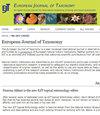Comparative and cladistic analyses of the species of the genus Pelodera Schneider, 1866 (Rhabditidae: Nematoda) belonging to the coarctata group
IF 1.3
3区 生物学
Q3 ENTOMOLOGY
引用次数: 0
Abstract
Three new species of the genus Pelodera Schneider, 1866 viz., P. indica sp. nov., P. adeeli sp. nov. and P. paratretzeli sp. nov. collected from dung beetles and P. cylindrica (Cobb, 1898) collected from soil samples, are described and illustrated. Pelodera indica sp. nov. is characterised by sexual dimorphism in anterior region, cupola-shaped tail with a spike; males having punctated, striated and lobed bursa with no genital papillae originating anterior to cloaca. Pelodera adeeli sp. nov. is characterised by coarsely annulated cuticle; relatively narrow stoma; tail conoid without spike; males with punctated, lobed bursa and nine pairs of genital papillae arranged in a 2/1+2+P+3+1 configuration. Pelodera paratretzeli sp. nov. is characterised by sexual dimorphism in anterior region, stoma wide with three well-developed metastegostomal denticles; tail cupola-shaped with a long spike; males having spicules fused distally up to 12–14% of spicule length; bursa peloderan, anteriorly closed and punctated with nine pairs of genital papillae arranged in a 3/2+P+3+1 configuration. Pelodera cylindrica is described with additional details. The comparative analysis as well as phylogenetic relationship of the species belonging to the coarctata group have been elaborated by incorporating scanning electron microscopic observations. Information on the biogeographical distribution has also been provided.属线虫科(横纹虫科:线虫科)种的比较与进化分析
Pelodera Schneider属三新种,1866年,即P.indica sp.nov.,P.adeeli sp.nov。Paratretzelli sp。11月。从粪甲虫和P。对从土壤样品中采集的柱状体(Cobb,1898)进行了描述和说明。印度Pelodera indica sp。11月。其特征是前部区域两性异形,圆顶状的尾巴有一个尖刺;雄性有点状、条纹状和浅裂的囊,在泄殖腔前面没有生殖乳头。阿氏Pelodera adeeli sp。11月。其特征是角质层有粗糙的环状;相对狭窄的造口;没有穗状花序的尾圆锥形;雄性,有点状的裂囊和9对生殖器乳头,排列成2/1+2+P+3+1的构型。Pelodera paratretzelli sp.nov.的特征是前部区域两性异形,气孔宽,有三个发育良好的后剑鞘小齿;尾部圆顶形状有一个长尖刺;具有向远端融合的针状物的雄性,其长度可达针状物长度的12-14%;peloderan囊,前部闭合,有9对生殖器乳头,排列成3/2+P+3+1构型。柱状Pelodera cylindrica描述了更多的细节。结合扫描电子显微镜观察,阐述了属于缩窄亚纲的物种的比较分析和系统发育关系。还提供了关于生物地理分布的信息。
本文章由计算机程序翻译,如有差异,请以英文原文为准。
求助全文
约1分钟内获得全文
求助全文
来源期刊

European journal of taxonomy
ZOOLOGY-
CiteScore
2.30
自引率
8.30%
发文量
173
审稿时长
29 weeks
期刊介绍:
EJT is a fully refereed, international, fully electronic Open Access journal in descriptive taxonomy, covering subjects in zoology, entomology, botany (in its broadest sense), and palaeontology. EJT-papers must be original and adhere to high scientific (content) and technical (language, artwork, etc.) standards. Manuscripts that are clearly substandard in either of these categories will not be sent out for review. EJT is supported by a consortium of European Natural History Institutes, but its scope is global. Both authorship and geographical region of study need not be European. Authors are, however, strongly encouraged to involve European Natural History collections by consulting material or by depositing specimens (e.g. types and figured material) related to their published paper in the collection of a European Natural History Institute.
 求助内容:
求助内容: 应助结果提醒方式:
应助结果提醒方式:


